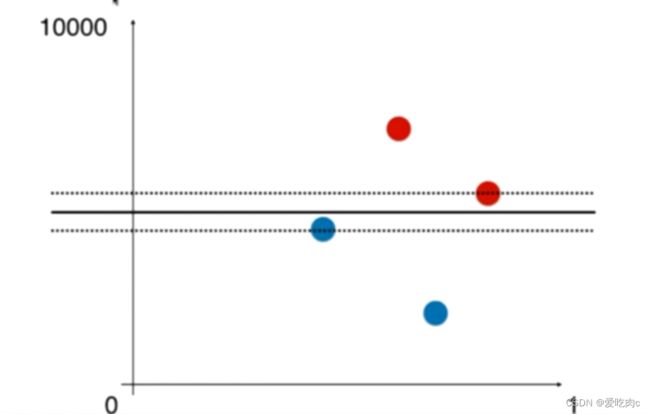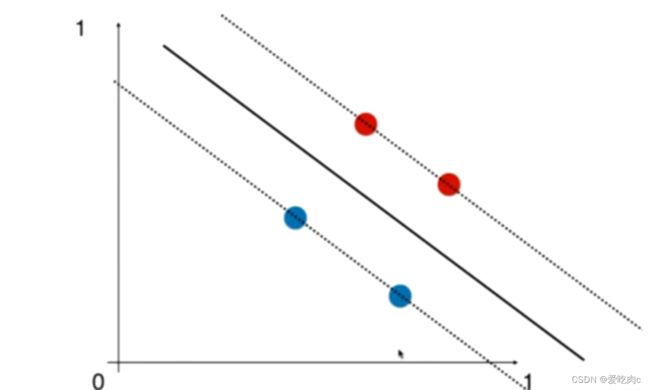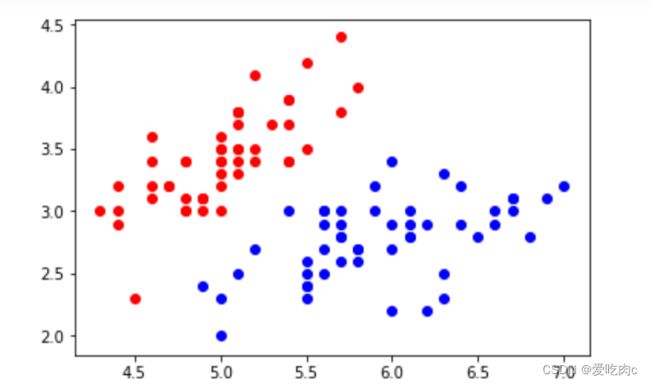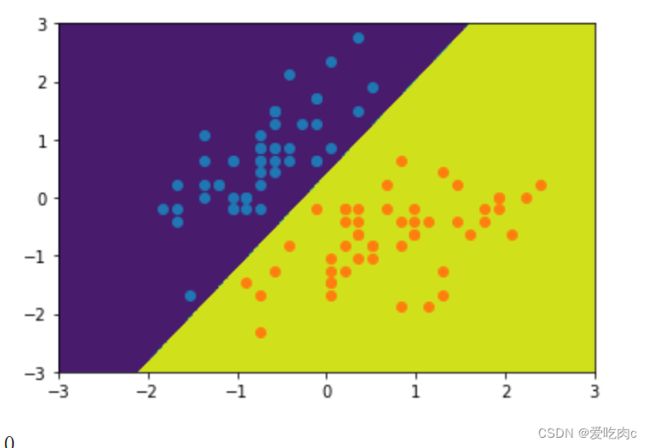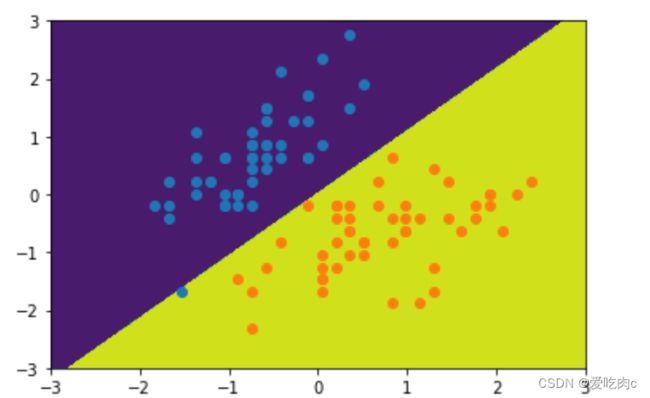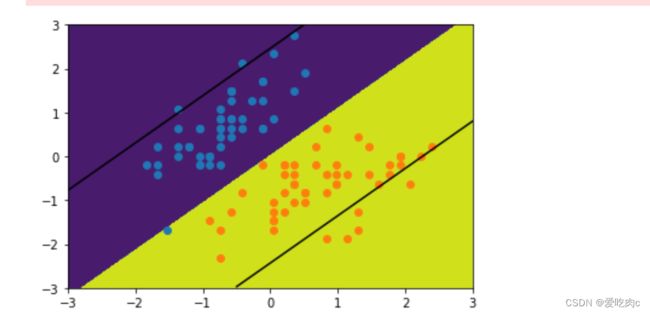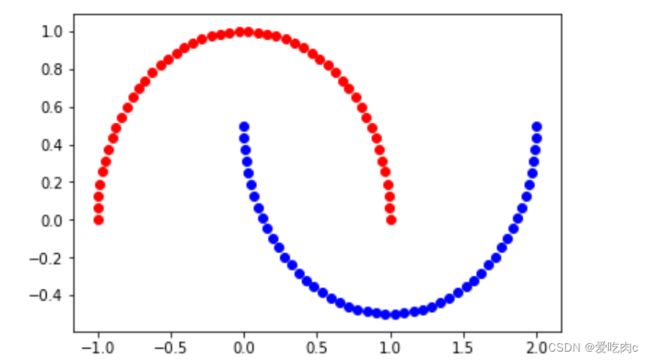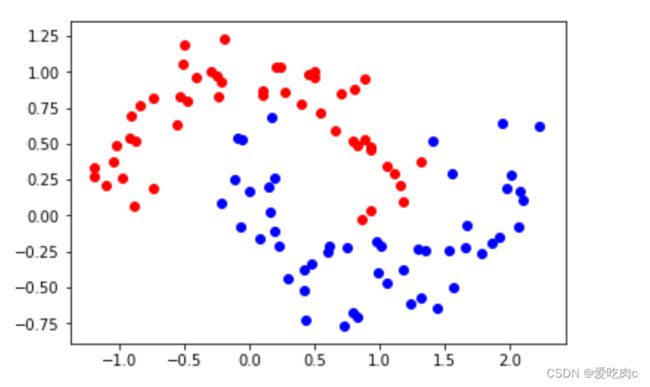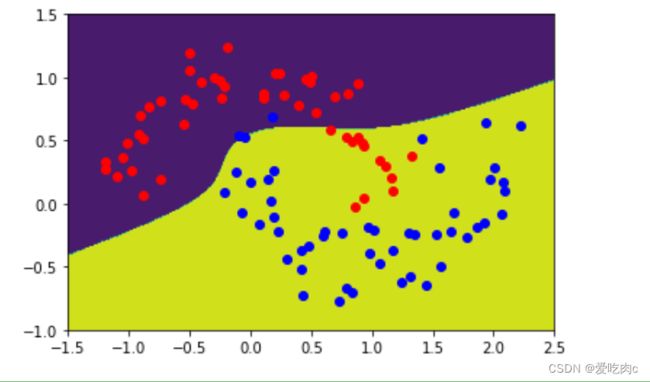支撑向量机 SVM
文章目录
- 前言
- 一、SVM是什么?
-
- 1、回顾逻辑回归
- 2、SVM求决策边界
- 二、SVM最大化margin (hard margin svm)
- 三、soft margin svm
-
- 1、引入
- 四、sklearn中的SVM
-
- 1、首先注意数据标准化
- 2、sklearn中的SVM
- 五、使用SVM来解决非线性问题
-
- 1、使用多项式特征的SVM
- 2、使用多项式核函数的SVM
- 总结
前言
一、SVM是什么?
SVM(support vector machine ) 支撑向量机
既可以解决分类问题也可以解决回归问题。
1、回顾逻辑回归
对于分类问题,比如逻辑回归,我们通常会使用一个决策边界来将不同的类别划分开来。
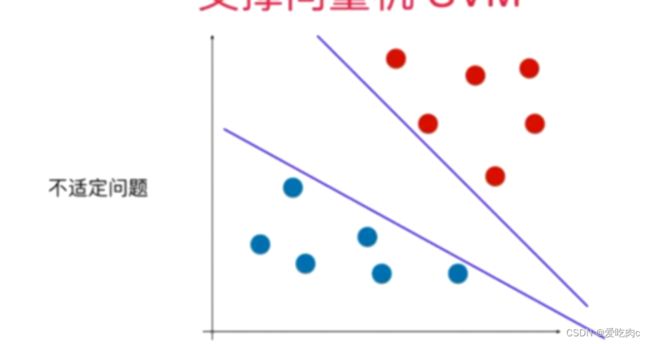
比如有不同的决策边界(称为不适定问题),如何找到最好的决策边界呢?逻辑回归是采用了损失函数,之后通过最小化损失函数来找到该决策边界。
那SVM是如何来寻找决策边界呢?
2、SVM求决策边界

SVM是尝试寻找一个最优的决策边界:通过让两个类别中最近的样本距离该决策边界最远,同时该决策边界还能很好的划分该样本点。
这些离决策边界最近的点就称为支撑向量
不同类别的支撑向量之间的距离称为margin
SVM的目的就是要最大化margin
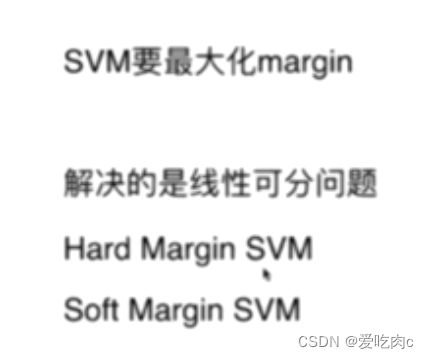
Hard Margin SVM 解决的是线性可分问题 决策边界可以没有错误的将样本点划分同时最大化了margin值
Soft Margin SVM 为了解决线性不可分问题
为了最大化margin,我们一定要先求出margin的数学表达式,之后求出其中的未知数,来最大化。
这也是我们机器学习尤其时参数学习中一个常用的思想:
将我们解决问题的思路变为了一个最优化问题,之后就是最优化目标函数
二、SVM最大化margin (hard margin svm)
margin=2d 所以即最大化d 就需要列出d的数学形式 引出点到直线的距离
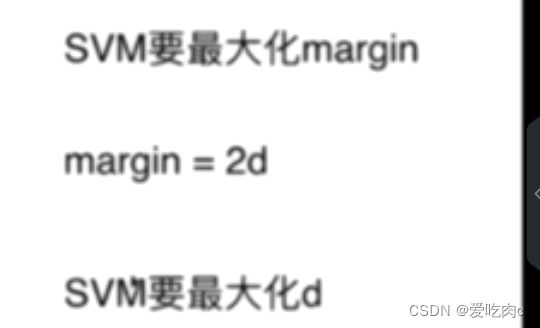
那我们就要求点到直线的距离
扩展到n维
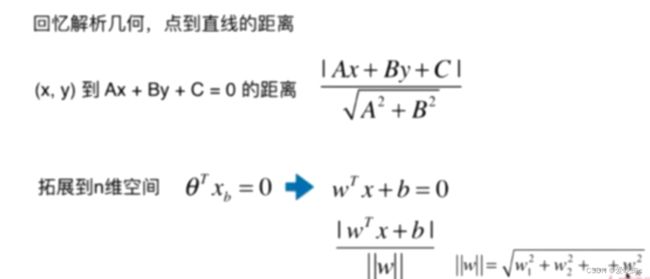
在这里我们把二分类中的0和1改为1和-1这两类,只要区分开就行,没影响

||w||d是一个常数,我们让wt 和b都除以这个常数 可以得到:
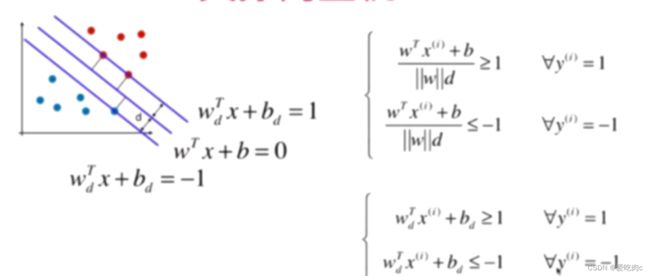
由于Wtx+b=0的右边部分为0,所以我们也可以让其同时除以||w||d
就变为统一的格式了

同时都用Wd和bd表示太过于麻烦,我们可以直接写为Wtx+b的形式
但这里的Wt与之前的Wt不同,这里是除以了||w||d.

同时我们可以将上下两类写成一个式子,就变成了如图所示的式子
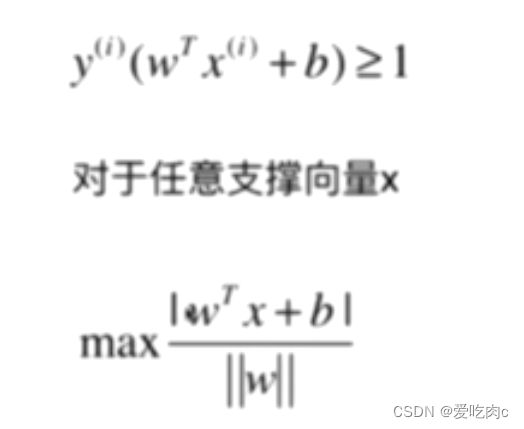
又由于支撑向量的直线的值都为1或-1,化简之后
为了方便求导,写成平方
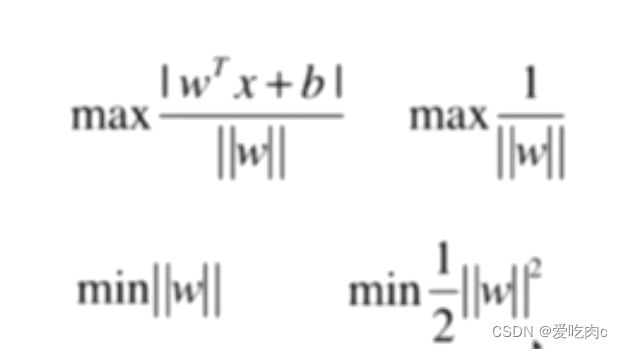
同时,这与我们之前讲的最优解问题不同,这是有条件的最优解问题,是局部的,而不是全局的,如果是全局的那么我们可以求导即可。但这里不行。
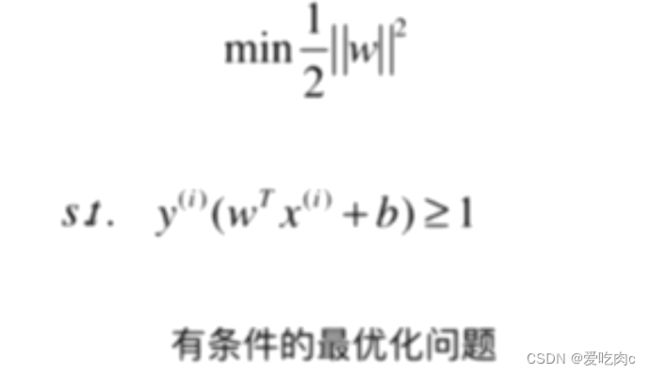
三、soft margin svm
1、引入
hard margin svm 首先要能正确分出不同类
比如这个图:
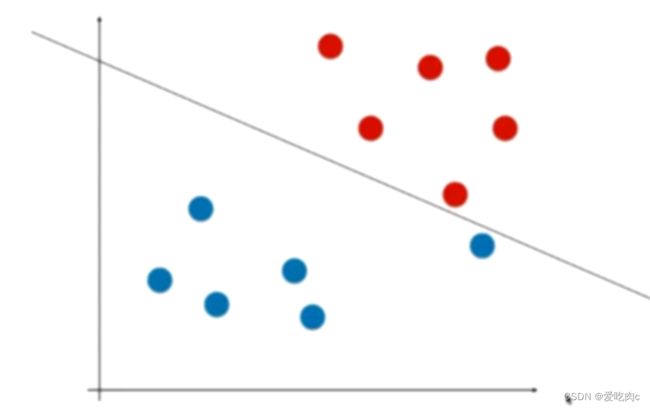
我们看这个图,觉得分类没问题,但是如果对于测试数据集,这个模型的泛化能力并不好,我们可以看到大多数蓝色点都在左下方,而这条直线却受了那一个蓝色极端点的影响。
又如:
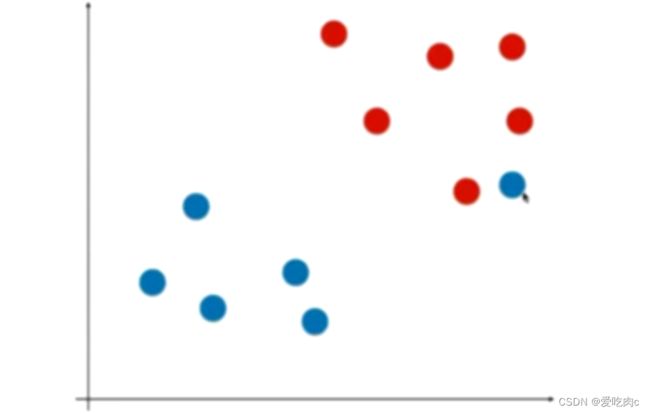
这是一个非线性问题,我们根本没有办法找到一条可以正确分类的决策边界。
所以此时就要引入soft margin svm。
允许模型有一定的容错能力。

所以引入了一个参数,这使得模型有了一定的容错能力。如果是简单的hard margin svm 则要求所有的点都在margin外,在margin内部不得有样本点, 但是加上了这个系数之后,我们就使得margin内部也可以有少部分点,有了容错能力。相当于一个正则项。

与以往的正则项相同,我们都需要在前面加上一个超参数,来平衡两者。
如果C越大,如果取一个极端值无穷大的话那我们就逼迫这这个参数为0,此时soft margin 就变为了 hard margin。
如果c越小,则我们的容错能力就越强。
更好的理解正则项,正则项可以是我们通过训练数据集来训练模型的时候,少受极端数据的影响。使模型能够有更好的泛化能力。
四、sklearn中的SVM
1、首先注意数据标准化
和KNN算法一样svm也涉及到距离,所以我们需要先将数据标准化。
如图:如果两个样本特征量纲不同的话,像上边那幅图,就会受y轴这个样本特征的影响。
如果在相同的维度上,决策边界应该变成这样
2、sklearn中的SVM
SVM可以用来解决回归和分类问题
**svc天然的可以解决多分类问题,**所以它的系数coef_这些返回的都是二维矩阵,有多条直线,对应多条直线的系数
import numpy as np
import matplotlib.pyplot as plt
from sklearn import datasets
iris=datasets.load_iris()
x=iris.data
y=iris.target
x=x[y<2,:2] #先解决二分类问题 且为了可视化 我们先选择两个样本特征
y=y[y<2]
plt.scatter(x[y==0,0],x[y==0,1],color='r')
plt.scatter(x[y==1,0],x[y==1,1],color='b')
plt.show()
from sklearn.preprocessing import StandardScaler #数据归一化
standsca=StandardScaler()
standsca.fit(x)
stand_x=standsca.transform(x)
from sklearn.svm import LinearSVC #解决分类问题的svc
svc=LinearSVC(C=1e9)#先让c很大,C很大,则相当于hard margin svm
svc.fit(stand_x,y)
绘制决策边界
def plot_decision_boundary(model,axis):
x0,x1=np.meshgrid(
np.linspace(axis[0],axis[1],int((axis[1]-axis[0]))*100).reshape(-1,1),
np.linspace(axis[2],axis[3],int((axis[3]-axis[2]))*100).reshape(-1,1)
)
x_new=np.c_[x0.ravel(),x1.ravel()]
y_predict=model.predict(x_new)
zz=y_predict.reshape(x0.shape)
from matplotlib.colors import ListedColormap
custom_camp=ListedColormap(['#EF9A9A','#FFF59D','#90CAF9'])
plt.contourf(x0,x1,zz,linewidth=5,camp=custom_camp)
plot_decision_boundary(svc,[-3,3,-3,3])
plt.scatter(stand_x[y==0,0],stand_x[y==0,1])
plt.scatter(stand_x[y==1,0],stand_x[y==1,1])
plt.show()
绘制带margin的决策边界 c很大时 相当于hard soft margin
def plot_svc_decision_boundary(model,axis):
x0,x1=np.meshgrid(
np.linspace(axis[0],axis[1],int((axis[1]-axis[0]))*100).reshape(-1,1),
np.linspace(axis[2],axis[3],int((axis[3]-axis[2]))*100).reshape(-1,1)
)
x_new=np.c_[x0.ravel(),x1.ravel()]
y_predict=model.predict(x_new)
zz=y_predict.reshape(x0.shape)
from matplotlib.colors import ListedColormap
custom_camp=ListedColormap(['#EF9A9A','#FFF59D','#90CAF9'])
plt.contourf(x0,x1,zz,linewidth=5,camp=custom_camp)
w=model.coef_[0]
b=model.intercept_[0]
#w0*x0+w1*x1+b=0
#->x1=-w0/w1*x0-b/w1 #根据x0就能绘制x1
plot_x=np.linspace(axis[0],axis[1],200)
up_y=-w[0]/w[1]*plot_x-b/w[1]+1/w[1] #上边那条margin
down_y=-w[0]/w[1]*plot_x-b/w[1]-1/w[1] #下边那条
up_index=(up_y>=axis[2])&(up_y<=axis[3]) #为了防止得到的y超出边界
down_index=(down_y>=axis[2])&(down_y<=axis[3])
plt.plot(plot_x[up_index],up_y[up_index],color='black')
plt.plot(plot_x[down_index],down_y[down_index],color='black')
plot_svc_decision_boundary(svc,[-3,3,-3,3])
plt.scatter(stand_x[y==0,0],stand_x[y==0,1])
plt.scatter(stand_x[y==1,0],stand_x[y==1,1])
plt.show()
svc2=LinearSVC(C=0.01)#先让c很大,C很大,则相当于hard margin svm
svc2.fit(stand_x,y)
y_predict=svc2.predict(stand_x)
plot_decision_boundary(svc2,[-3,3,-3,3])
plt.scatter(stand_x[y==0,0],stand_x[y==0,1])
plt.scatter(stand_x[y==1,0],stand_x[y==1,1])
plt.show()
plot_svc_decision_boundary(svc2,[-3,3,-3,3])
plt.scatter(stand_x[y==0,0],stand_x[y==0,1])
plt.scatter(stand_x[y==1,0],stand_x[y==1,1])
plt.show()
测试一下所有样本下的 不同的决策边界 对应的分类准确度
有兴趣的也可以测试一个极度偏斜的数据对应的精准率 召回率等指标
iris=datasets.load_iris()
x=iris.data
y=iris.target
from sklearn.model_selection import train_test_split
x_train,x_test,y_train,y_test=train_test_split(x,y,random_state=666)
from sklearn.preprocessing import StandardScaler #数据归一化
standsca=StandardScaler()
standsca.fit(x_train)
stand_x_train=standsca.transform(x_train)
stand_x_test=standsca.transform(x_test) #测试数据集 也要在训练数集得到的方差等数据上进行归一化
from sklearn.svm import LinearSVC #解决分类问题的svc
svc=LinearSVC(C=1e9)#先让c很大,C很大,则相当于hard margin svm
svc.fit(stand_x_train,y_train)
y_predict=svc.predict(stand_x_test)
svc.score(stand_x_test,y_predict)
1.0
svc2=LinearSVC(C=0.01)
svc2.fit(stand_x_train,y_train)
y2_predict=svc2.predict(stand_x_test)
svc.score(stand_x_test,y2_predict)
0.789…
五、使用SVM来解决非线性问题
1、使用多项式特征的SVM
import numpy as np
import matplotlib.pyplot as plt
from sklearn import datasets
x,y=datasets.make_moons()
plt.scatter(x[y==0,0],x[y==0,1],color='r')
plt.scatter(x[y==1,0],x[y==1,1],color='b')
plt.show()
#添加噪声
x,y=datasets.make_moons(noise=0.15,random_state=666)
plt.scatter(x[y==0,0],x[y==0,1],color='r')
plt.scatter(x[y==1,0],x[y==1,1],color='b')
plt.show()
from sklearn.preprocessing import StandardScaler,PolynomialFeatures
from sklearn.pipeline import Pipeline
from sklearn.svm import LinearSVC
def polysvm(degree,C=1.0):
return Pipeline([
('poly',PolynomialFeatures(degree=degree)),
('std',StandardScaler()),
('svc',LinearSVC(C=C))
])
def plot_decision_boundary(model,axis):
x0,x1=np.meshgrid(
np.linspace(axis[0],axis[1],int((axis[1]-axis[0]))*100).reshape(-1,1),
np.linspace(axis[2],axis[3],int((axis[3]-axis[2]))*100).reshape(-1,1)
)
x_new=np.c_[x0.ravel(),x1.ravel()]
y_predict=model.predict(x_new)
zz=y_predict.reshape(x0.shape)
from matplotlib.colors import ListedColormap
custom_camp=ListedColormap(['#EF9A9A','#FFF59D','#90CAF9'])
plt.contourf(x0,x1,zz,linewidth=5,camp=custom_camp)
poly_svc=polysvm(degree=3)
poly_svc.fit(x,y)
plot_decision_boundary(poly_svc,[-1.5,2.5,-1.0,1.5])
plt.scatter(x[y==0,0],x[y==0,1],color='r')
plt.scatter(x[y==1,0],x[y==1,1],color='b')
plt.show()
2、使用多项式核函数的SVM
from sklearn.svm import SVC
def polykernelsvm(degree,C=1.0):
return Pipeline([
('std',StandardScaler()),
('svc',SVC(kernel="poly",degree=degree,C=C))
])
poly_kernelsvc=polykernelsvm(degree=3)
poly_kernelsvc.fit(x,y)
plot_decision_boundary(poly_kernelsvc,[-1.5,2.5,-1.0,1.5])
plt.scatter(x[y==0,0],x[y==0,1],color='r')
plt.scatter(x[y==1,0],x[y==1,1],color='b')
plt.show()
总结
下篇文章讲解 核函数 高斯核函数等
